Lord Dhanwantari ‘The God of Ayurveda’
Article by Dr Manasa
Lord Dhanwantari is popularly known as ‘The God of Ayurveda’. At the beginning of all the auspicious works, many clinical works and any works, Ayurveda folks offer prayers and worship to the holy feet of Lord Dhanwantari.
Lord Dhanwantari is believed to have manifested during the manifestation of Samudra Manthana or the churning of the ocean of milk holding a vessel filled with ambrosia (amrita). He is believed to be an incarnation of Lord Vishnu and was the profounder of medical science, Ayurveda.
Table of Contents
Watch video
Samudra Manthana
The story of Samudra Manthana (Churning of the ocean of milk) –
Churning of the ocean is mentioned in Mahabharata, Vishnupurana, Bhagavatha Purana and Vayu Purana.
Samudra Manthan or churning of the ocean of milk is said to be an event which had occurred in mythological period. It is one of the most famous stories narrated in the Puranas. Kumbha Mela, a largest fair and festival which attracts lacks of devotees, pilgrims and visitors which happens once in 12 years is celebrated in India as a mark of Samudra Manthan.
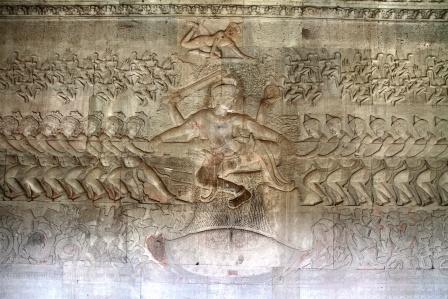
Reference – The story of Samudra Manthana appears in Srimad Bhagavatha, the Mahabharata and the Vishnu Purana.
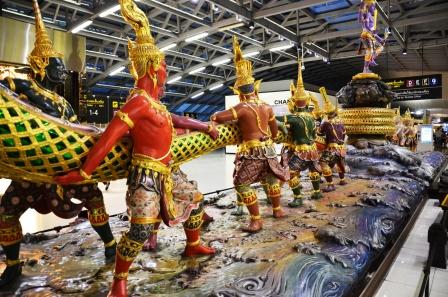
Churning of the milk ocean –
Long ago, Lord Indra, the king of Gods was enjoying the songs sung by Gandharvas (celestial musicians) when sage Vasishta arrived. Indra being immersed and lost in the glory and celebration neither noticed his distinguished guest nor welcomed him. Getting furious with Indra’s behaviour, sage Vasishta walked out of Indra’s abode with anger.
Learning about this incident, King Bali, the lord of Patala Loka (depths of the earth) attacked Indra Loka (Indra’s territory) with a large army. The deities were defeated in the fierce battle that took place, Bali emerging victorious. Bali and his army brought all the wealth to Patala Loka. The demons could not enjoy the pleasure of enjoying the stolen wealth for long as the whole wealth got submerged into the ocean.
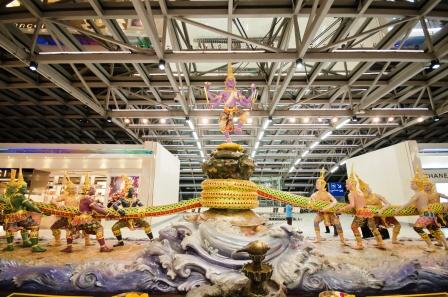
Bali got surprised and asked his teacher Shukracharya (teacher of the demons) about the reason for all this. Sage Shukracharya revealed to Bali that he could not enjoy the splendours of deities wealth because he had not performed 100 Ashwamedha Yagas (ritual sacrifice of ancient times).
On the other hand, the deities, after getting defeated when to seek Lord Vishnu’s health. Lord Brahma also accompanied them. Lord Vishnu wisely advised the deities to make a friendly treaty with the demons so that they could later retrieve all the stolen wealth from the ocean bed in a tricky way.
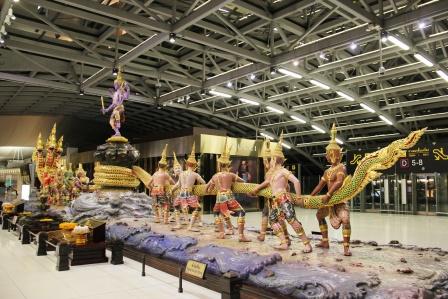
The deities, as instructed by Lord Vishnu went to Patala Loka and convinced the demons to participate in the churning of the ocean with a view of retrieving the wealth.
When the process of churning of the ocean began, Mandara parvat (mountain) was used as a churner and the serpent Vasuki, Vishnu’s snake was used as the rope.
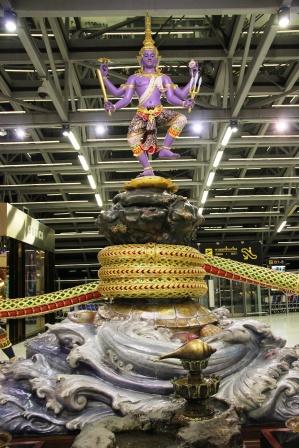
Both demons and deities immersed the Mandara mountain into the ocean but it sank down as there was no base upon which it could be placed. So Lord Vishnu took the form of a tortoise and held the mountain on his back (Kurma incarnation of Lord Vishnu).
Churning of the ocean resulted into the emergence of many valuable things like –
Sura – goddess and creator of alcohol
Apsaras – various divine nymphs like Rambha, Menaka etc
Kausthubha – the most valuable jewel in the world
Uchchaishravas – the divine 7 headed horse
Kalpa Vriksha – the wish granting tree
Kamadhenu – the first cow and mother of all the other cows in the world
Airavatha – the white elephant of Lord Indra
Lakshmi – the goddess of fortune and wealth
Parijatha – the divine tree
Halahala – the deadly poison
Chandra – the moon
Dhanwantari – the doctor
Amrita – the ambrosia etc
When the poison emerged from the ocean bed, neither deities nor the demons claimed it. The poison was so fatal that the whole world started getting inflamed by it. Lord Shiva then drank the Halahala poison and this caused the throat to turn blue. Due to this he is called as Nilakantha (the blue throated Lord). In this way the world was saved. Lord Vishnu accepted goddess Lakshmi as his consort.
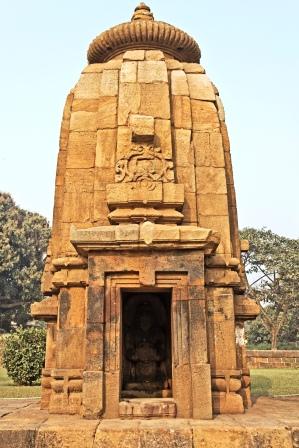
Emergence of Ambrosia
When Lord Dhanwantari appeared with a pot of ambrosia in his hands, a demon named Vrishparva snatched it from him. All the demons then take off to Patala Loka with the pot of Ambrosia. Lord Vishnu disguised himself as an enchanting beauty, Mohini and went to Patala Loka. Then he found all the demons fighting among themselves for ambrosia. The demons were stunned by the beauty of Mohini.
Mohini took control of the pot of Ambrosia and summoned the deities to Patala Loka.
All the deities and demons were made to sit in 2 separate rows. Mohini started distributing the ambrosia to deities. A demon named Rahu, disguised himself as a deity sat amidst deities. Mohini on noticing and identifying Rahu, severed his head with Sudarshana Chakra (divine discus) even before he could consume the ambrosia. Mohini could identify Rahu based on the information given by Surya (Sun God) and Chandra (Moon God). The head due to its contact with ambrosia remained immortal. To avenge on Surya and Chandra on exposing him, it is believed that this immortal head of Rahu occasionally swallows the Sun or the Moon, causing eclipses. Then, the Sun or Moon escapes through the opening at the neck, ending the eclipse. Shiva kept Chandra in his hair lock. Meanwhile, Rahu too came chasing Chandra and Lord Shiva wore his head as a garland around his neck.
Dhanwantari
Lord Vishnu is said to have taken his 13th incarnation as Lord Dhanwantari. He manifested himself from the ocean holding a vessel filled with ambrosia.
Even though Lord Brahma (creator of the universe) is said to be the first teacher and propagator of Ayurveda, Lord Dhanwantari is considered and worshipped as ‘God of Ayurveda’
Dhanwantari was the physicians of the Gods in the heaven. He is said to have incarnated in this world in the form of Divodasa, the king of Kasi.
Dhanwantari (Divodasa) was the master of surgery and he taught it to Sushruta, Aupadhenava, Vaitarana, Aurabhra, Poushkalavata, Karavirya, Gopurarakshita etc
The below said are the references about Dhanwantari –
Dhanwantari arose during the churning of the ocean of Ambrosia (Samudra Manthan or Amrita Manthan)
Dhanwantari – the king of Kasi
Divodasa Dhanwantari – the preceptor of Sushruta
Incarnation of Dhanwantari
Kashyapa Prajapati is said to have had 2 wives by names Diti and Aditi. The progeny through Diti were known as Daityas or Danavas (demons), they had dominantly the qualities of Rajas and Tamas (destructive qualities). The sons of Aditi were known as Suras (Gods) and they were adorned with Satva Guna (beneficial qualities).
Both Suras and Asuras used to quarrel with each other. Once they prayed to Lord Vishnu to bestow them with immortality. Then Lord Vishnu suggested that they shall churn the ocean of milk to get Ambrosia (Amrita).
During the process of churning of the ocean by the Gods and Demons, along with the Moon, Goddess Lakshmi, Kausthubha, Kalakuta Visha, Airavata etc, Lord Dhanwantari rose with Amrita Kalasa (pot of Ambrosia).
According to Vishnu Purana and Agni Purana ‘Dhanwantari’ who rose from the ocean during Samudra Manthana was the incarnation of Lord Vishnu
In Harivamsha, Vayu Purana and Brahmanda Purana also it was quoted that Lord Vishnu might have born as Dhanwantari, the son of Dhanva, the king of Kashi.
Genealogical tree of King of Kasi –
Kasa -> Deerghatapa -> Dhanwa -> Dhanwantari -> Ketuman -> Bhimaradha -> Divodasa-> Pratardana ->Vatsa -> Alarkas
Lord Dhanwantari who was born out of the ocean of milk was called ‘Abju’ by Lord Vishnu (means – born from water)
Dhanwantari asked Lord Vishnu for special status and share in sacrificial acts. Lord Vishnu replied telling that since all portfolios were filled, his desire would be fulfilled in the next epoch i.e. Dwapara Yuga.
Hence in Dwapara Yuga, Lord Vishnu incarnated as Dhanwantari and was born as the son of the king of Dhanwa, the king of Kasi. Lord Dhanwantari learned the life science from the sage Bharadhwaja. Later, he taught the life science of Ayurveda to his disciples Sushruta, Aupadhenava, Aurabhra etc.
Dhanwantari had a son named Ketuman. Ketuman had one son namely Bhimaradha. Bhimaradha’s son was Divodasa who later went on to become the king of Kasi or Varanasi.
Every year the auspicious day of Ashwayuja Bahula Trayodasi is celebrated as ‘Dhanwantari Jayanthi’ by the Ayurveda folks. This festival is also famous as Dhanteras.
In Sushruta Samhita, it is seen that Dhanwantari, Divodasa and Kasi Raja are the different names of the same individual
Works of Dhanwantari
- Chikitsa Tatwa Vignana – By Dhanwantari
- Chikitsa Darshana – By Divodasa
- Chikitsa Koumudi – By Kasiraja
- Ajeernamrita Manjari – By Kasiraja
- Roga Nidana – By Dhanwantari
- Vaidya Chintamani – By Dhanwanthari
- Dhanwantari Nighantu – By Dhanvanthari (A dictionary of Materia Medica and Therapeutics)
- Vaidyaka Bhaskarodaya – By Dhanvanthari
- Chikitsa Sara Sangraha – By Dhanwantri
Formulations by Dhanvantari
- Dhanwantari Ghrita
- Pashupata Rasa
- Mrityunjaya Loha
- Vari Shoshana Rasa
- Rasa Rajendra
- Ashwagandhadi Taila
- Saptavimshati Guggulu
- Rasabhra Guggulu
Meaning of Dhanwantari
Dhanu or Dhanwa means surgery, Anta means end, Dhanwantari means the science of surgery or the end of surgical or science knowledge (or ultimate reference of surgical science).









